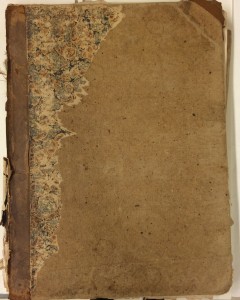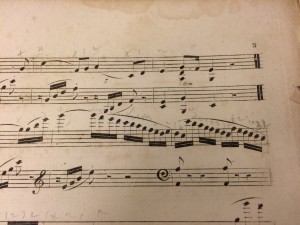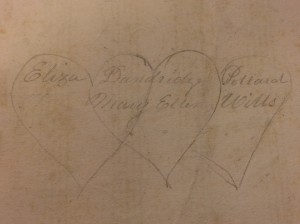A Window into Nineteenth-century Parlor Music
 Nineteenth-century bound sheet music offers a window into domestic music making. The accouterments of musical life—instruments and sheet music—were recognizable symbols of elite taste and education. Much nineteenth-century sheet music was bound together into volumes by owners, sometimes with ornate, personalized covers and marbled endpapers. Collecting loose sheaves of music into a bound volume gave the music greater permanency and value; bound volumes became objects for display as well as use in the parlor. Symbols of status and taste, a piano and sheet music were ubiquitous fixtures of most middle- and upper-class American parlors.
Nineteenth-century bound sheet music offers a window into domestic music making. The accouterments of musical life—instruments and sheet music—were recognizable symbols of elite taste and education. Much nineteenth-century sheet music was bound together into volumes by owners, sometimes with ornate, personalized covers and marbled endpapers. Collecting loose sheaves of music into a bound volume gave the music greater permanency and value; bound volumes became objects for display as well as use in the parlor. Symbols of status and taste, a piano and sheet music were ubiquitous fixtures of most middle- and upper-class American parlors.

The Ruffin-Pollard Bound Music Volume pictured here, was in use in the mid-nineteenth century, primarily by Eliza Dandridge Pollard. Several pieces within the volume have pencil inscriptions indicating they were gifts from James Edward Ruffin to his cousin Eliza. Popular ballads and political songs are interspersed with more serious repertoire for piano solo. Some the more artistically challenging music displays marginalia in the form of numerical indications called fingerings; these are penciled in above several intricate passages to remind the musician of which fingers to use for ease of performance.

Typical of sheet music of the 1830s through 1850s, several of the ballads feature pictorial title-pages. These lithographs and engravings added to the visual appeal of sheet music as objects for display and enjoyment.
Ruffin-Pollard Bound Music Volume, 1828-1860
Mss. Acc.2007.49


